Device capable of notifying operation state change thereof through network and communication method of the device
Yu , et al.
U.S. patent number 10,623,550 [Application Number 16/042,699] was granted by the patent office on 2020-04-14 for device capable of notifying operation state change thereof through network and communication method of the device. This patent grant is currently assigned to Samsung Electronics Co., Ltd.. The grantee listed for this patent is Samsung Electronics Co., Ltd.. Invention is credited to Woo-yong Chang, Min-jeong Moon, Se-jun Park, Seung-dong Yu.
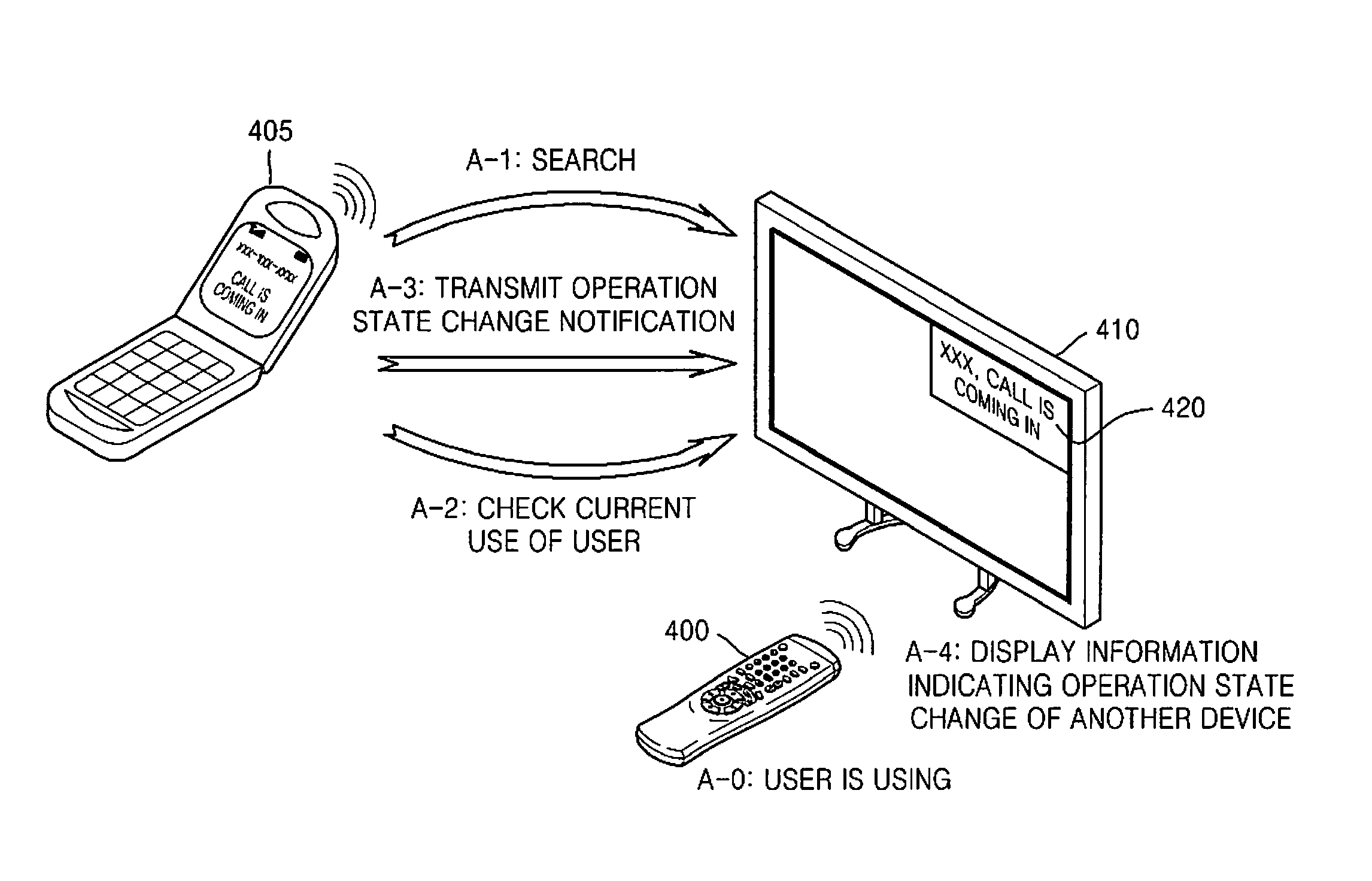
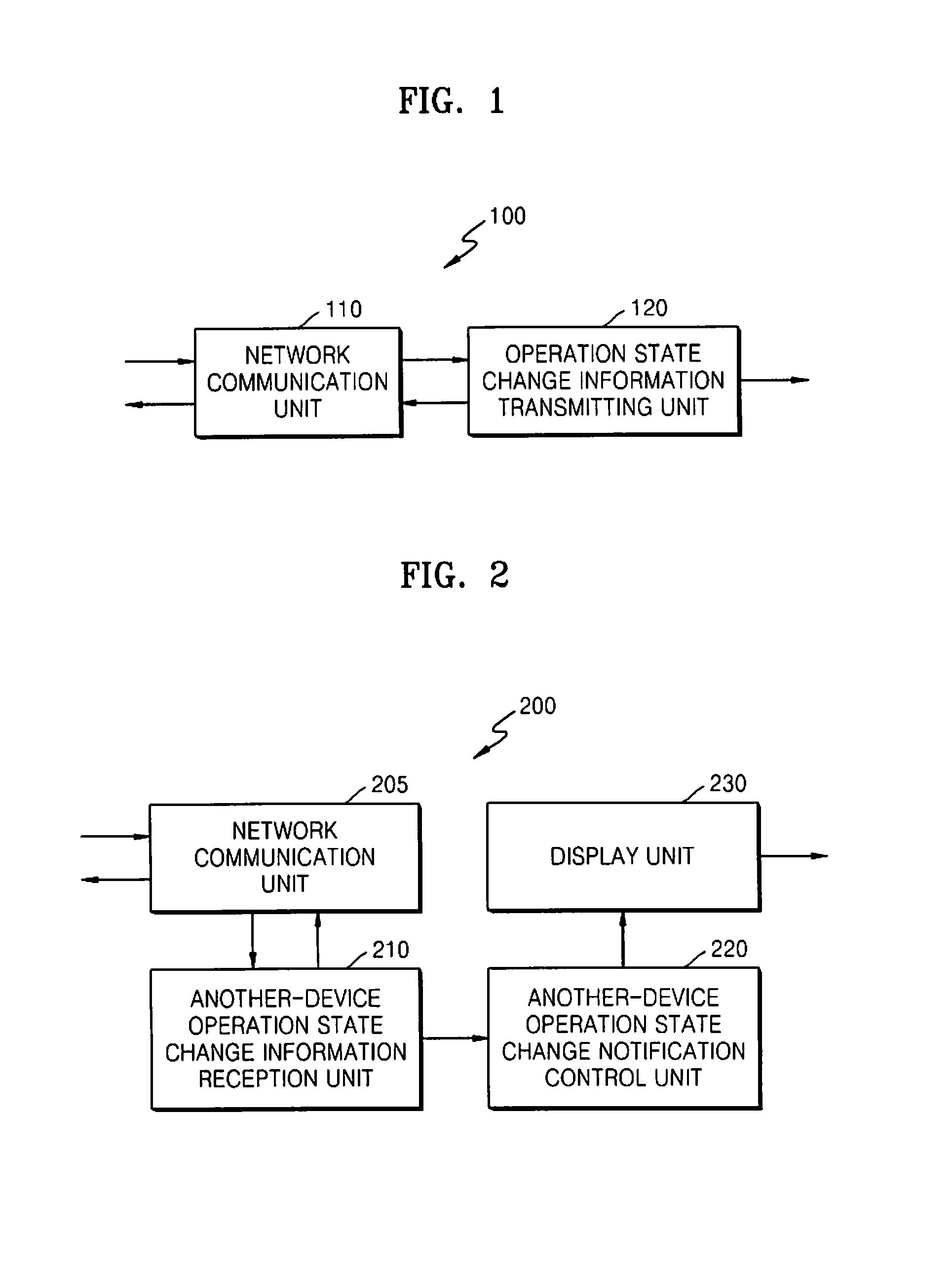
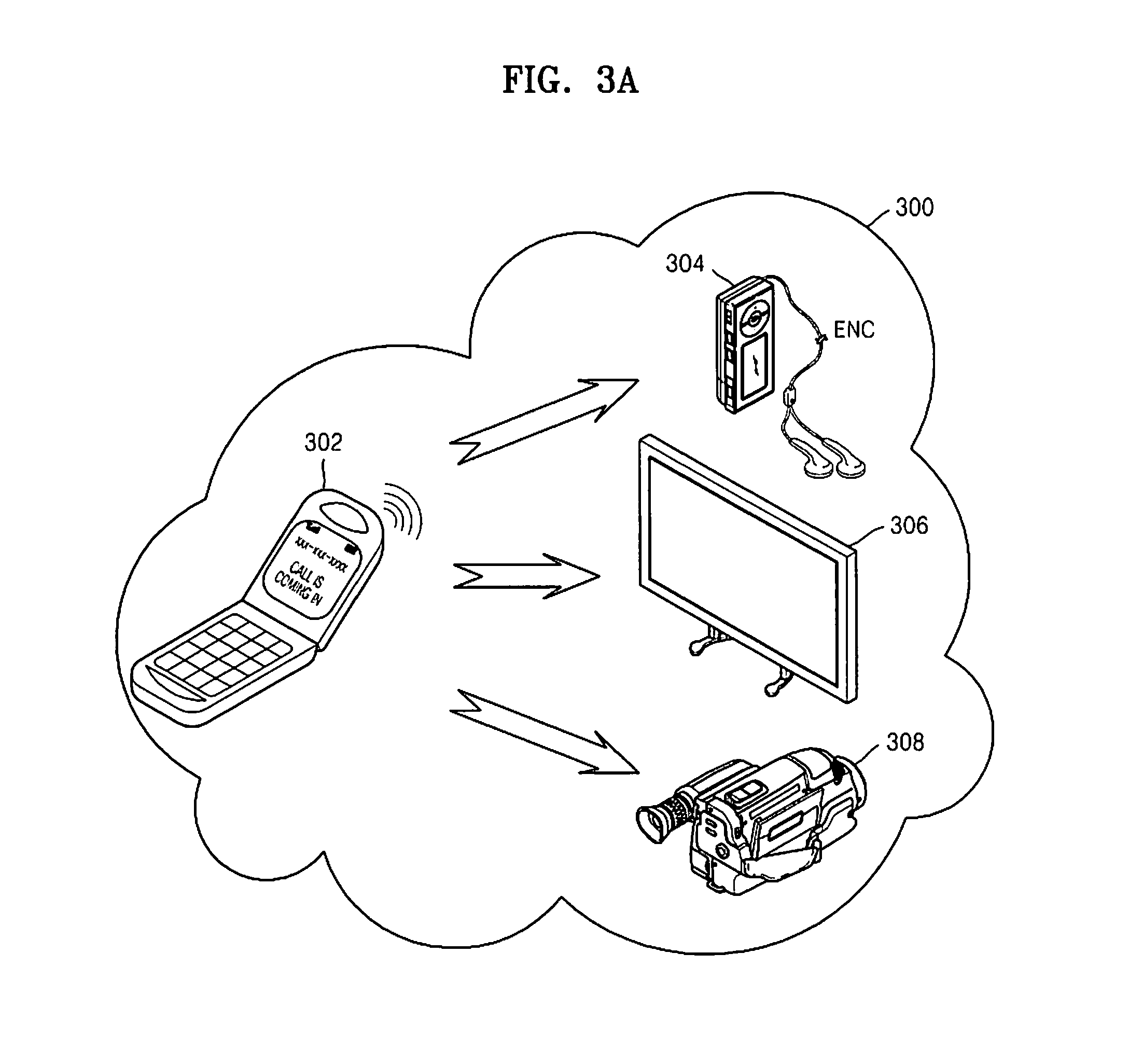
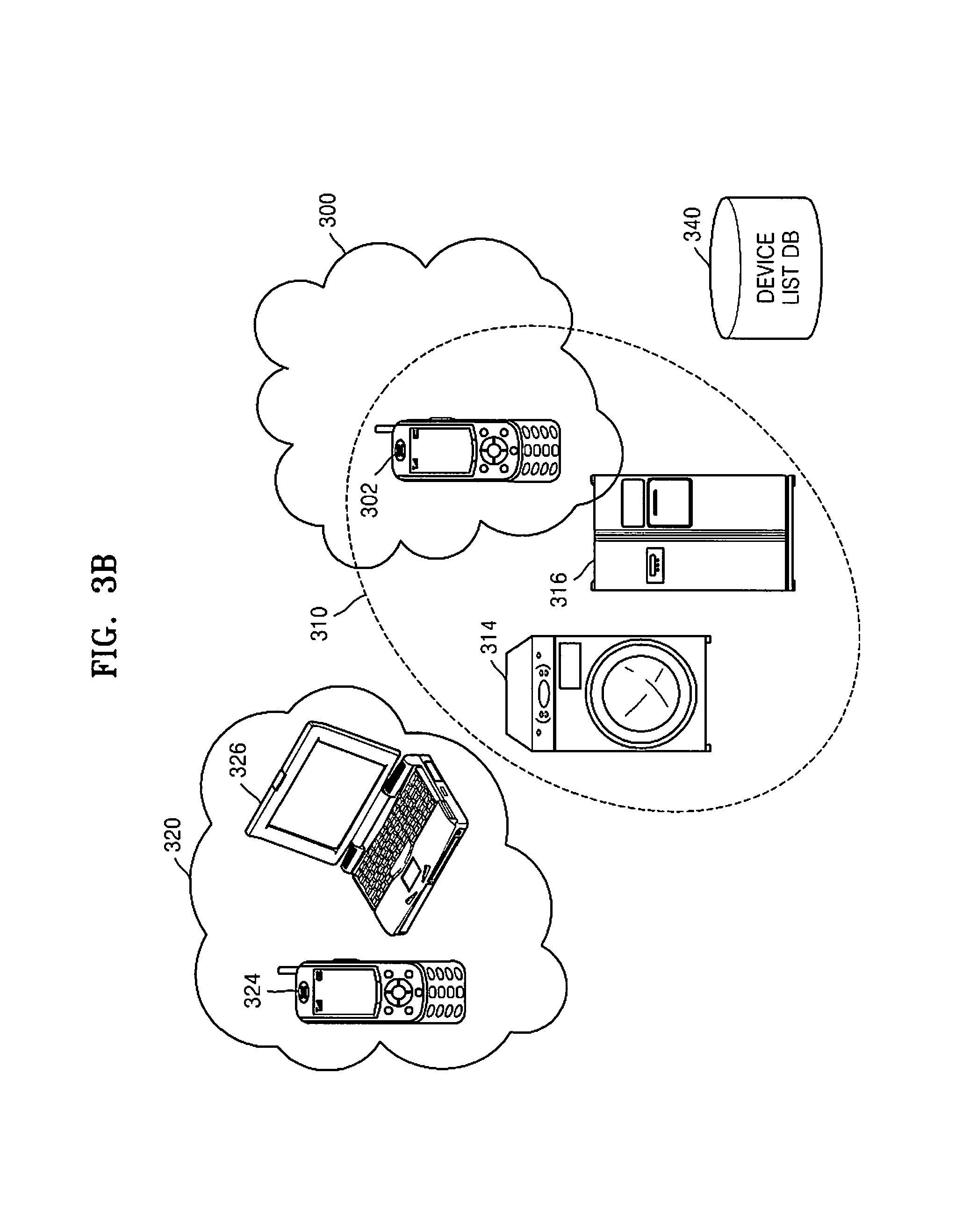
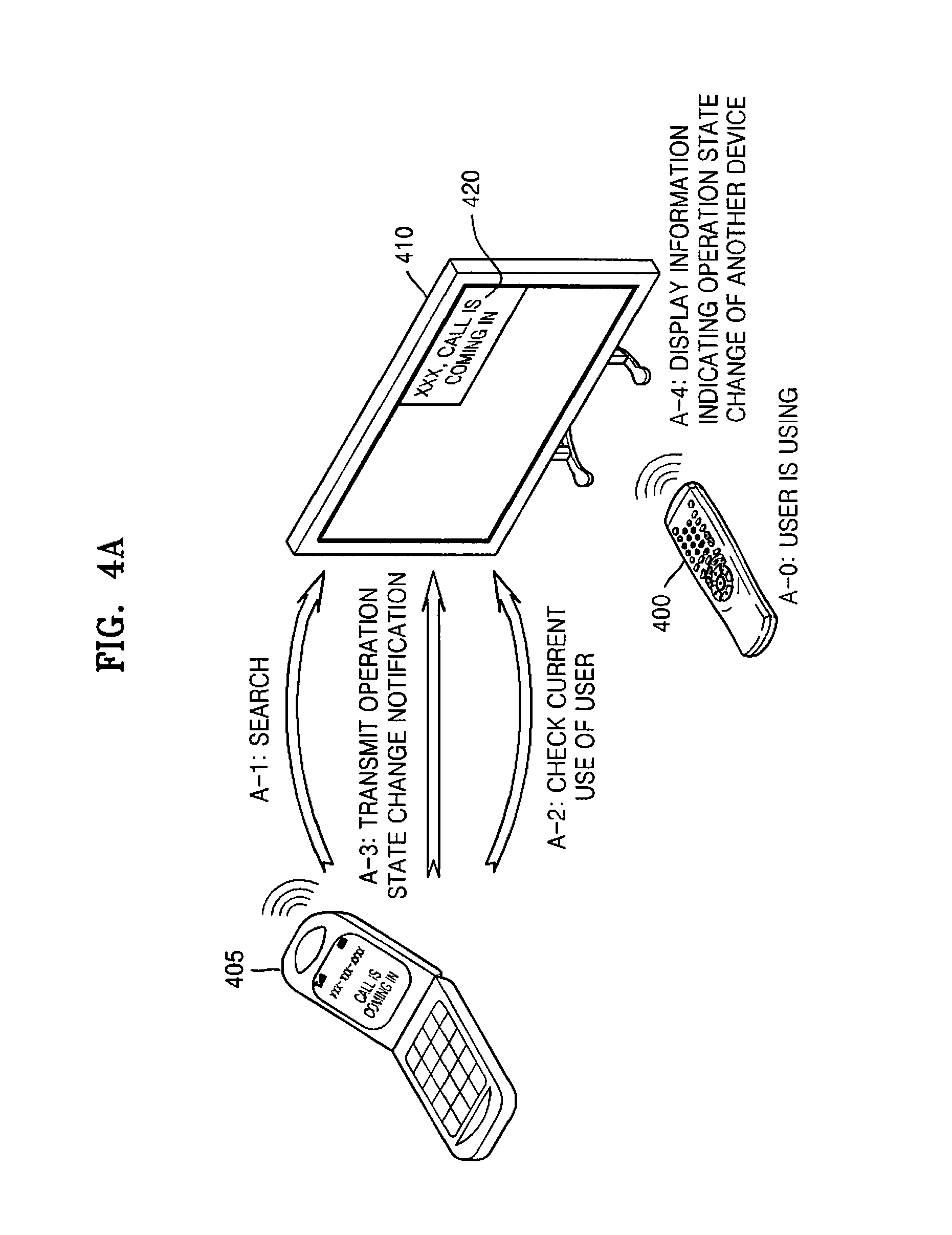
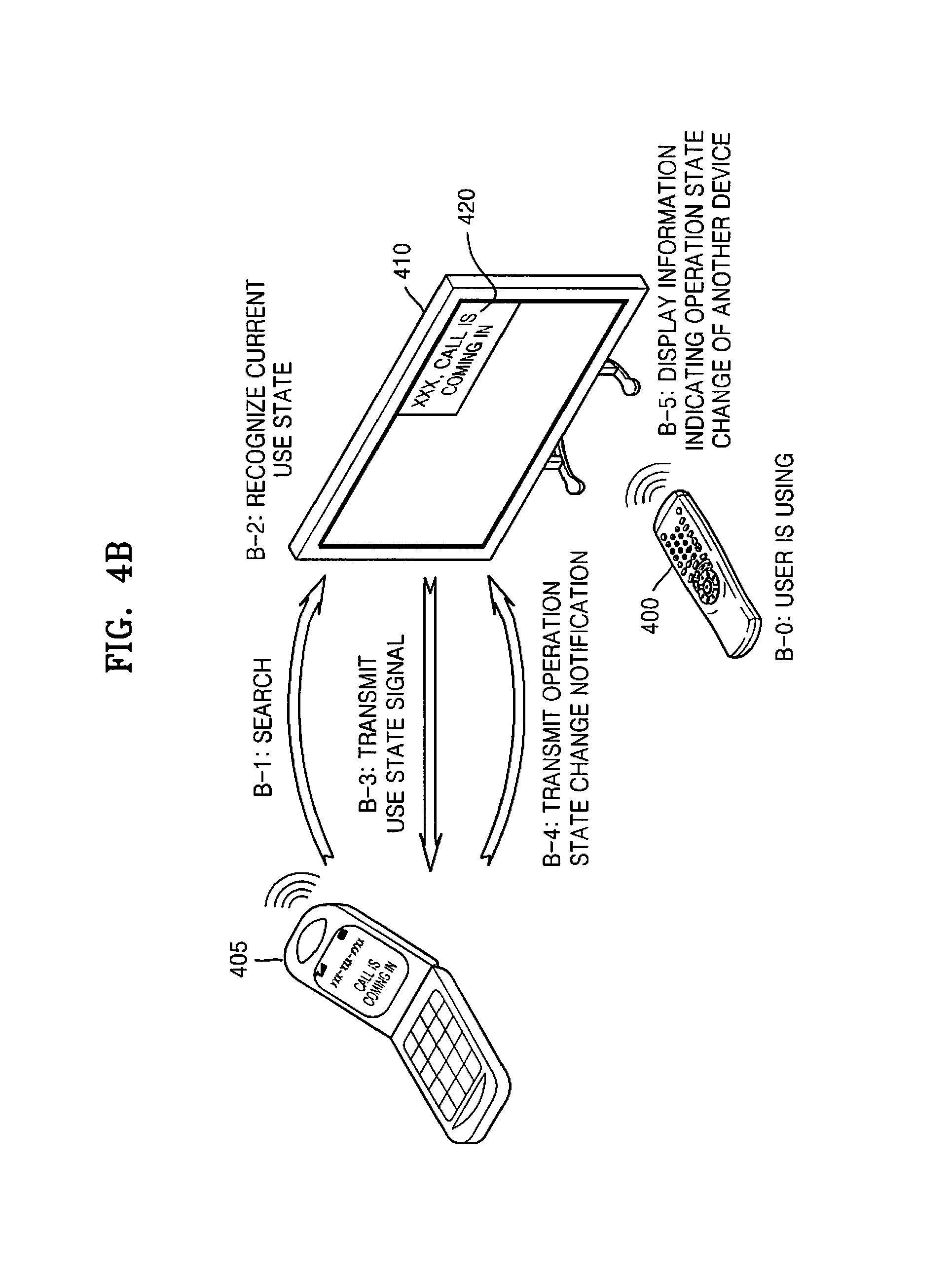
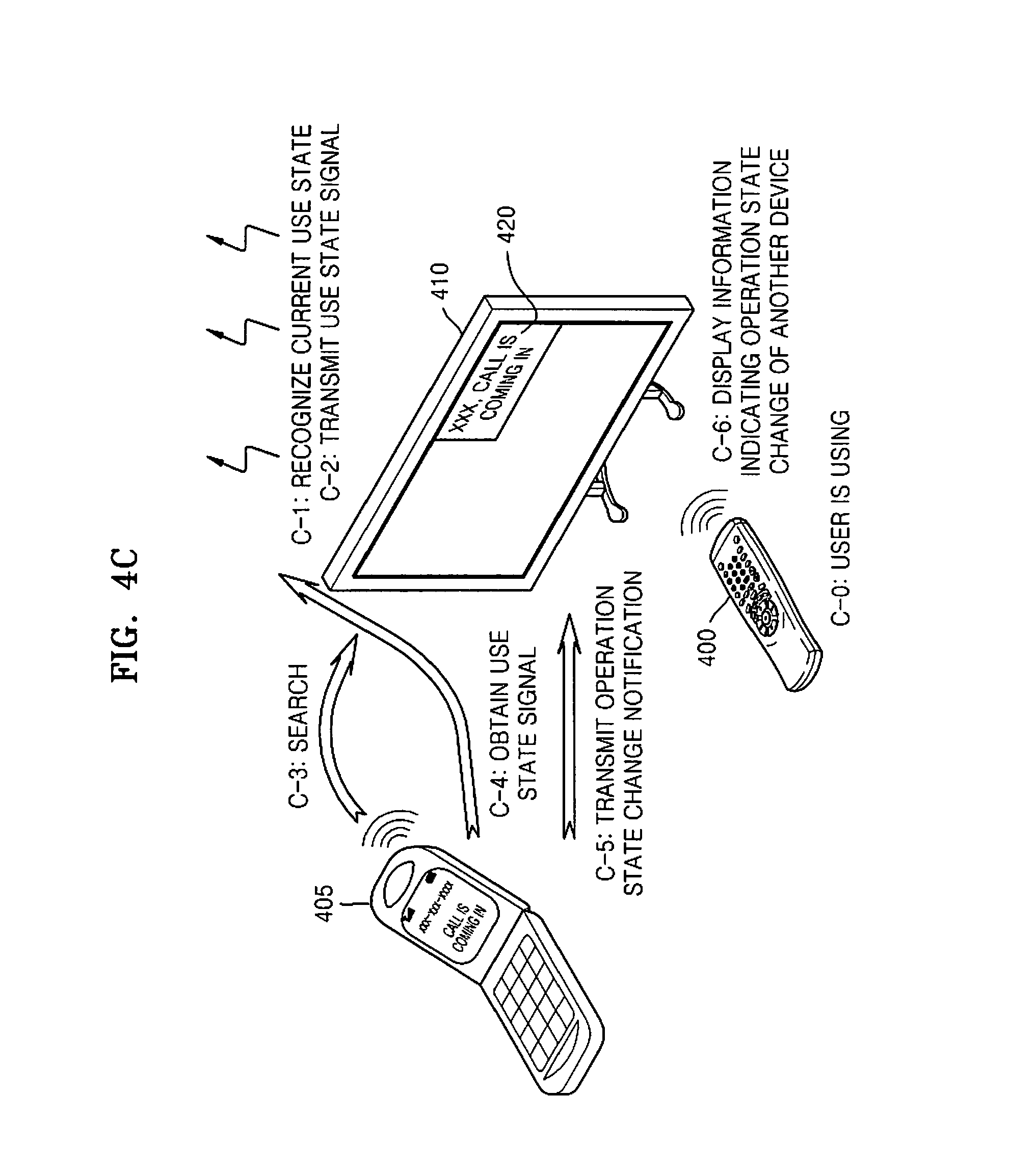
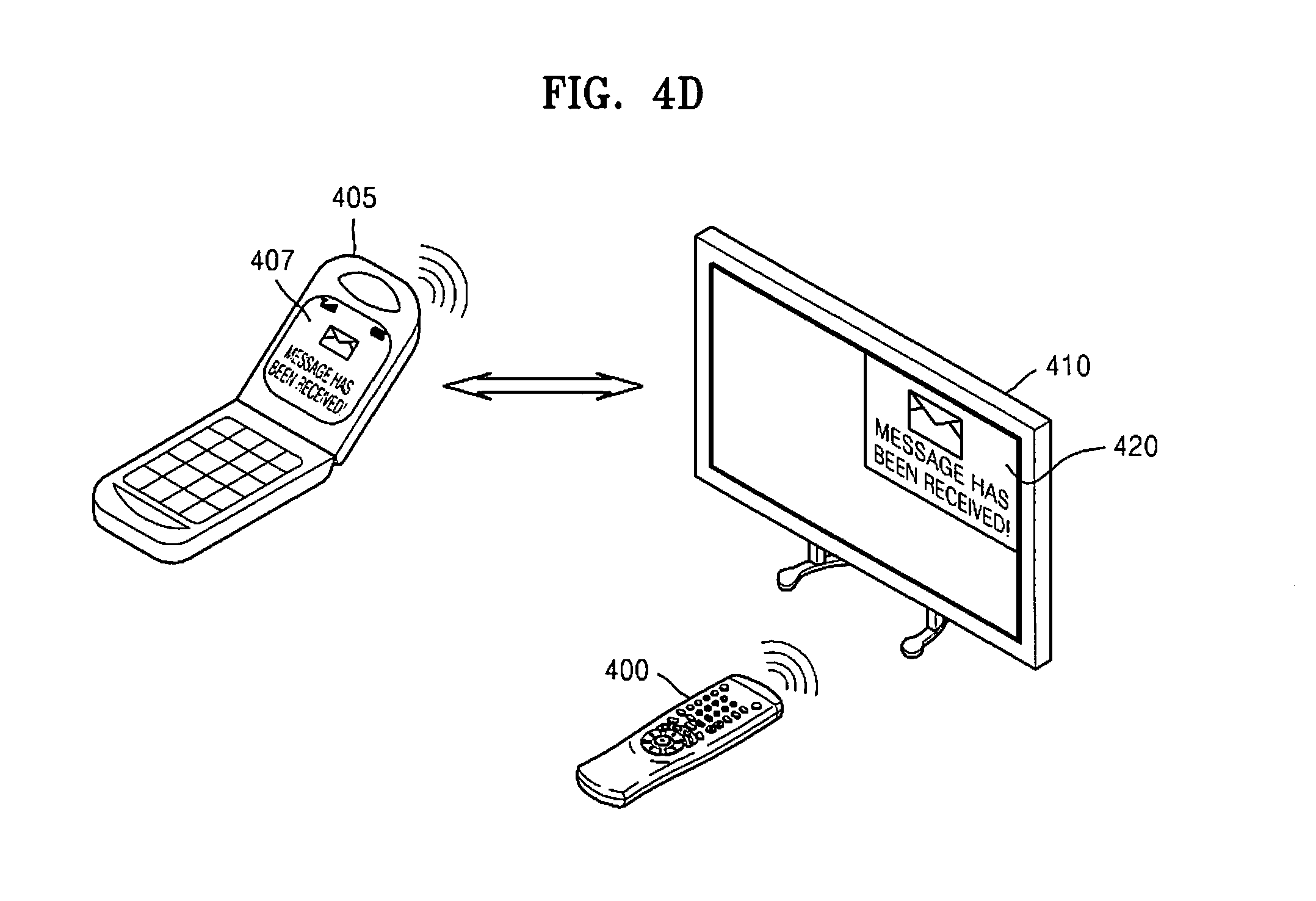
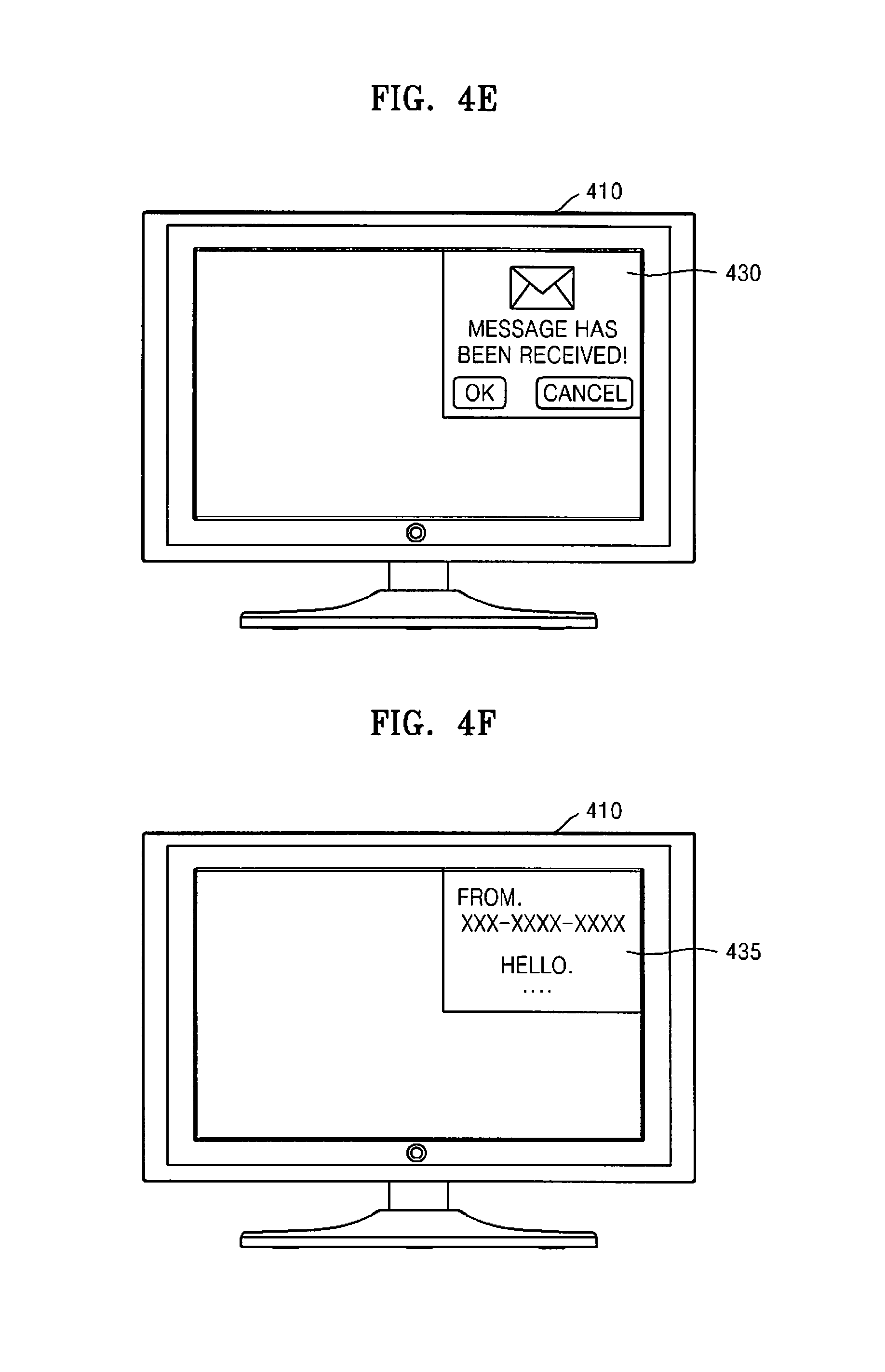
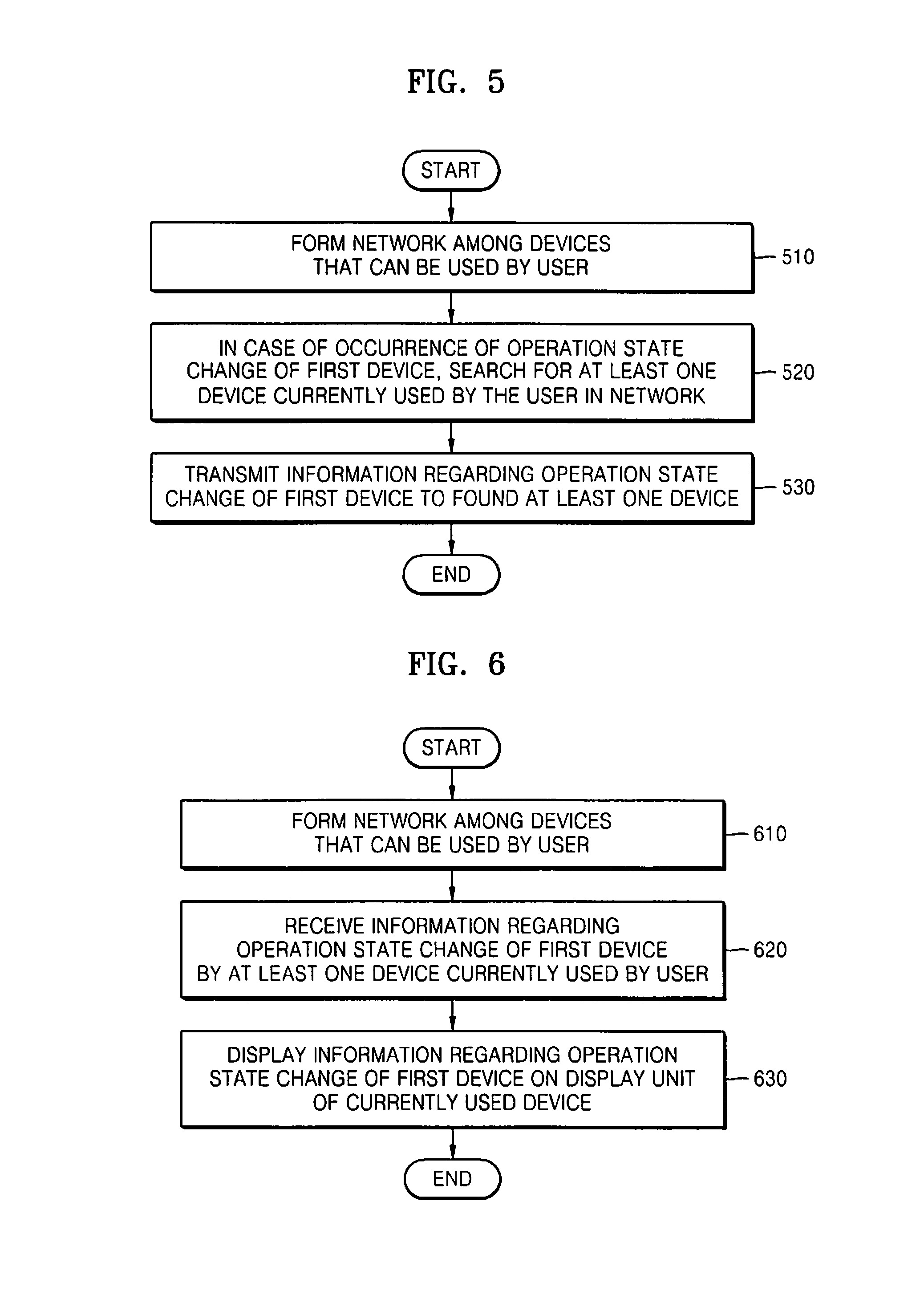
| United States Patent | 10,623,550 |
| Yu , et al. | April 14, 2020 |
Device capable of notifying operation state change thereof through network and communication method of the device
Abstract
A method of notifying a user of a message received by a first device of the user is provided. The method includes connecting, by the first device, to a second device of the user through a local communication network, wherein the second device is currently registered by the first device; receiving, by the first device, a message, from an external device of another user; in response to determining the first device is not currently being used when the message is received, determining whether the registered second device is currently being used; and transmitting notification information of the received message to the second device currently being used by the user, wherein a notification regarding the received message is displayed on a display of the second device currently being used by the user.
| Inventors: | Yu; Seung-dong (Gyeonggi-do, KR), Chang; Woo-yong (Gyeonggi-do, KR), Park; Se-jun (Gyeonggi-do, KR), Moon; Min-jeong (Gyeonggi-do, KR) | ||||||||||
|---|---|---|---|---|---|---|---|---|---|---|---|
| Applicant: |
|
||||||||||
| Assignee: | Samsung Electronics Co., Ltd.
(KR) |
||||||||||
| Family ID: | 43304871 | ||||||||||
| Appl. No.: | 16/042,699 | ||||||||||
| Filed: | July 23, 2018 |
Prior Publication Data
| Document Identifier | Publication Date | |
|---|---|---|
| US 20180332159 A1 | Nov 15, 2018 | |
Related U.S. Patent Documents
| Application Number | Filing Date | Patent Number | Issue Date | ||
|---|---|---|---|---|---|
| 15216347 | Jul 21, 2016 | 10033849 | |||
| 14847885 | Jul 26, 2016 | 9401982 | |||
| 14270684 | Sep 8, 2015 | 9131065 | |||
| 12861522 | May 6, 2014 | 8718638 | |||
Foreign Application Priority Data
| Aug 21, 2009 [KR] | 10-2009-0077873 | |||
| Oct 30, 2009 [KR] | 10-2009-0104662 | |||
| Current U.S. Class: | 1/1 |
| Current CPC Class: | H04M 1/7253 (20130101); H04M 11/08 (20130101); H04M 1/72597 (20130101); H04L 12/2827 (20130101); H04M 1/57 (20130101); H04M 1/72527 (20130101) |
| Current International Class: | H04M 1/725 (20060101); H04M 1/57 (20060101); H04L 12/28 (20060101); H04M 11/08 (20060101) |
References Cited [Referenced By]
U.S. Patent Documents
| 5809212 | September 1998 | Shasha |
| 6192116 | February 2001 | Mayak |
| 6574662 | June 2003 | Sugiyama et al. |
| 6631407 | October 2003 | Mukaiyama et al. |
| 6731201 | May 2004 | Bailey et al. |
| 6906617 | June 2005 | Van der Meulen |
| 6924727 | August 2005 | Nagaoka et al. |
| 6930598 | August 2005 | Weiss |
| RE40032 | January 2008 | van Bokhorst et al. |
| 7376393 | May 2008 | Ono et al. |
| 7395326 | July 2008 | Hikida et al. |
| 7474889 | January 2009 | Bhakta et al. |
| 7756975 | July 2010 | Cronk |
| 7930433 | April 2011 | Sugai et al. |
| 7970413 | June 2011 | Oshimi et al. |
| 8019875 | September 2011 | Nielsen |
| 8089503 | January 2012 | Bruce et al. |
| 8117470 | February 2012 | Oh et al. |
| 8122506 | February 2012 | Harvey et al. |
| 8150982 | April 2012 | Zhang et al. |
| 8185594 | May 2012 | Duncan et al. |
| 8572182 | October 2013 | Klassen |
| 8634703 | January 2014 | Barton |
| 8646000 | February 2014 | Kang |
| 8738809 | May 2014 | Shoji |
| 8762240 | June 2014 | Sogo et al. |
| 9131065 | September 2015 | Yu et al. |
| 9225750 | December 2015 | Belz |
| 9270945 | February 2016 | St. John-Larkin |
| 2002/0015481 | February 2002 | Abel |
| 2002/0037699 | March 2002 | Kobayashi |
| 2002/0193149 | December 2002 | Tanaka et al. |
| 2003/0041134 | February 2003 | Sugiyama et al. |
| 2003/0135666 | July 2003 | Kim |
| 2004/0077313 | April 2004 | Oba |
| 2005/0021610 | January 2005 | Bozionek et al. |
| 2005/0149967 | July 2005 | Hanley |
| 2005/0189423 | September 2005 | Kurobe |
| 2005/0250552 | November 2005 | Eagle |
| 2005/0261018 | November 2005 | Yamamoto |
| 2006/0036672 | February 2006 | Cha et al. |
| 2006/0036678 | February 2006 | Rhim |
| 2006/0040705 | February 2006 | Kawakami et al. |
| 2006/0140187 | June 2006 | Fujinami |
| 2006/0161635 | July 2006 | Lamkin |
| 2006/0229014 | October 2006 | Harada |
| 2007/0021848 | January 2007 | Huang |
| 2007/0023904 | February 2007 | Salmon |
| 2007/0060054 | March 2007 | Romesburg |
| 2007/0092256 | April 2007 | Nozue et al. |
| 2007/0121584 | May 2007 | Qiu et al. |
| 2007/0140084 | June 2007 | Chiba |
| 2007/0237115 | October 2007 | Bae et al. |
| 2007/0243830 | October 2007 | Isenmann |
| 2007/0244750 | October 2007 | Grannan |
| 2007/0287478 | December 2007 | Park |
| 2007/0300188 | December 2007 | Kim |
| 2008/0013504 | January 2008 | Nishibayashi et al. |
| 2008/0020806 | January 2008 | Iwase |
| 2008/0064376 | March 2008 | Lee |
| 2008/0077998 | March 2008 | Hirosawa |
| 2008/0143517 | June 2008 | Goffin |
| 2008/0161034 | July 2008 | Akiyama |
| 2008/0171562 | July 2008 | Mehta |
| 2008/0174415 | July 2008 | Tanida et al. |
| 2008/0214206 | September 2008 | Shimanuki |
| 2008/0224834 | September 2008 | Oosaka et al. |
| 2008/0244026 | October 2008 | Holt |
| 2008/0248750 | October 2008 | Tsui |
| 2008/0252928 | October 2008 | Takatini |
| 2008/0266174 | October 2008 | Medina Herrero |
| 2008/0274743 | November 2008 | Kim |
| 2009/0060155 | March 2009 | Chingon |
| 2009/0062939 | March 2009 | Park |
| 2009/0073871 | March 2009 | Ko et al. |
| 2009/0124286 | May 2009 | Hellfalk et al. |
| 2009/0210152 | August 2009 | Kawa |
| 2009/0234910 | September 2009 | Chung |
| 2009/0293070 | November 2009 | Greeff |
| 2009/0306793 | December 2009 | Takebayashi |
| 2010/0004034 | January 2010 | Suzuki |
| 2010/0005166 | January 2010 | Chung |
| 2010/0014529 | January 2010 | Takechi et al. |
| 2010/0057921 | March 2010 | Zhang et al. |
| 2010/0058417 | March 2010 | Rondeau |
| 2010/0082448 | April 2010 | Lin |
| 2010/0173677 | July 2010 | Fu |
| 2010/0199307 | August 2010 | Hall |
| 2010/0208746 | August 2010 | Rahman |
| 2010/0210290 | August 2010 | Riley |
| 2010/0257239 | October 2010 | Roberts |
| 2011/0045809 | February 2011 | Yu et al. |
| 2011/0054644 | March 2011 | Baek et al. |
| 2012/0110635 | May 2012 | Harvey et al. |
| 2012/0166660 | June 2012 | Zhang et al. |
| 2014/0289422 | September 2014 | Singh |
| 1961298 | May 2007 | CN | |||
| 101304350 | Nov 2008 | CN | |||
| 101325562 | Dec 2008 | CN | |||
| 101449565 | Jun 2009 | CN | |||
| 2002-217922 | Aug 2002 | JP | |||
| 2002-344568 | Nov 2002 | JP | |||
| 2002-359670 | Dec 2002 | JP | |||
| 2002-369257 | Dec 2002 | JP | |||
| 2003-162626 | Jun 2003 | JP | |||
| 2003-179545 | Jun 2003 | JP | |||
| 2004-015169 | Jan 2004 | JP | |||
| 2004-048280 | Feb 2004 | JP | |||
| 2004-341736 | Dec 2004 | JP | |||
| 2005-033635 | Feb 2005 | JP | |||
| 2006-018623 | Jan 2006 | JP | |||
| 2006-345425 | Dec 2006 | JP | |||
| 2009-010468 | Jan 2009 | JP | |||
| 1020040007857 | Jan 2004 | KR | |||
| 1020040035243 | Apr 2004 | KR | |||
| 1020040047325 | May 2004 | KR | |||
| 1020050094247 | Sep 2005 | KR | |||
| 102006011255 | Jan 2006 | KR | |||
| 1020060015965 | Feb 2006 | KR | |||
| 1020070035257 | Mar 2007 | KR | |||
| WO 2007/107863 | Sep 2007 | WO | |||
| WO 2008/138260 | Nov 2008 | WO | |||
Other References
|
Canadian Office Action dated Aug. 20, 2013 issued in counterpart application No. 2,769,216. cited by applicant . Russian Office Action dated Aug. 20, 2013 issued in counterpart application No. 2012106026/08. cited by applicant . Indonesian Office Action dated Jun. 26, 2013 issued in counterpart application No. WO0201201055. cited by applicant . Japanese Office Action dated Feb. 23, 2015 issued in counterpart application No. 2010-186287. cited by applicant . Canadian Office Action dated Apr. 7, 2015 issued in counterpart application No. 2,769,216. cited by applicant . Chinese Office Action dated Jun. 3, 2015 issued in counterpart application No. 201080037128.5. cited by applicant . Taiwanese Search Report dated Oct. 23, 2014 issued in counterpart application No. 10321477710. cited by applicant . Chinese Office Action dated Nov. 4, 2014 issued in counterpart application No. 201080037128.5. cited by applicant . Korean Office Action dated Nov. 14, 2015 issued in counterpart application No. 10-2009-0104662, 16 pages. cited by applicant . Russian Office Action dated Nov. 10, 2015 issued in counterpart application No. 2012106026/08, 45 pages. cited by applicant . Japanese Appeal Decision dated Jan. 18, 2016 issued in counterpart application No. 2010-186287, 35 pages. cited by applicant . Chinese Office Action dated Mar. 16, 2016 issued in counterpart application No. 201080037128.5, 20 pages. cited by applicant . Chinese Office Action dated Jun. 4, 2018 issued in counterpart application No. 201610286387.0, 14 pages. cited by applicant . Korean Office Action dated Aug. 16, 2016 issued in counterpart application No. 10-2009-0104662, 5 pages. cited by applicant . Korean Office Action dated Oct. 5, 2016 issued in counterpart application No. 10-2016-0119311, 10 pages. cited by applicant . Korean Office Action dated Jul. 1, 2017 issued in counterpart application No. 10-2016-0119311, 4 pages. cited by applicant . Korean Office Action dated May 11, 2017 issued in counterpart application No. 10-2016-0119311, 6 pages. cited by applicant . Korean Office Action dated Apr. 9, 2018 issued in counterpart application No. 10-2018-0035440, 10 pages. cited by applicant . Korean Office Action dated Jan. 25, 2018 issued in counterpart application No. 10-2016-0119311, 6 pages. cited by applicant . Korean Notice of Final Rejection dated Oct. 26, 2018 issued in counterpart application No. 10-2018-0035440, 7 pages. cited by applicant . Korean Notice of Amendment Dismissal dated Dec. 17, 2018 issued in counterpart application No. 10-2018-0035440, 4 pages. cited by applicant . Korean Notice of Final Rejection dated Dec. 17, 2018 issued in counterpart application No. 10-2018-0035440, 7 pages. cited by applicant . Chinese Office Action dated Jul. 9, 2019 issued in counterpart application No. 201610286387.0, 39 pages. cited by applicant . Chinese Office Action dated Nov. 5, 2019 issued in counterpart application No. 201610286387.0, 36 pages. cited by applicant. |
Primary Examiner: Rego; Dominic E
Attorney, Agent or Firm: The Farrell Law Firm, P.C.
Parent Case Text
PRIORITY
This application is a Continuation Application of U.S. patent application Ser. No. 15/216,347, filed in the U.S. Patent and Trademark Office on Jul. 21, 2016, which is a Continuation Application of U.S. patent application Ser. No. 14/847,885, filed in the U.S. Patent and Trademark Office on Sep. 8, 2015, issuing on Jul. 26, 2016 as U.S. Pat. No. 9,401,982, which is a Continuation Application of U.S. patent application Ser. No. 14/270,684, filed in the U.S. Patent and Trademark Office on May 6, 2014, now U.S. Pat. No. 9,131,065, which is a Continuation Application of U.S. patent application Ser. No. 12/861,522, filed in the U.S. Patent and Trademark Office on Aug. 23, 2010, now U.S. Pat. No. 8,718,638, and claims priority under 35 U.S.C. .sctn. 119(a) to Korean Patent Application No. 10-2009-0077873, filed on Aug. 21, 2009, and Korean Patent Application No. 10-2009-0104662, filed on Oct. 30, 2009, in the Korean Intellectual Property Office, the content of each of which is incorporated herein by reference.
Claims
What is claimed is:
1. A method of transmitting a message received by a first electronic device to a second electronic device, comprising: connecting to the second electronic device via a local communication network, wherein the second electronic device is registered with the first electronic device, while the first electronic device is connected to the second electronic device, receiving the message from an external device, and based on a user input not being detected within a predetermined period of time by the first electronic device, transmitting, to the second electronic device, via the local communication network, message information of the received message to cause the second electronic device to display, on a display of the second electronic device, a screen according to the transmitted message information while the display of the second electronic device is activated based on an object being sensed within a sensor sensing range by the second electronic device.
2. The method of claim 1, wherein a current use state of the second electronic device is determined based on being logged in by a user input.
3. The method of claim 1, wherein transmitting the message information of the received message comprises transmitting the message information of the received message to the second electronic device if the first electronic device is not currently being used by the user.
4. The method of claim 1, wherein a notifying function for transmitting the message information to the second electronic device is set on or off by a user input.
5. The method of claim 1, wherein the first electronic device is a cellular device.
6. The method of claim 1, wherein the local communication network is a wireless fidelity (Wi-Fi) network.
7. The method of claim 1, wherein the second electronic device is video and/or audio equipment.
8. The method of claim 1, wherein the message comprises a message which is sent to the first electronic device.
9. A first electronic device, comprising: a communication circuitry; a memory storing instructions; and one or more processors configured to execute the instructions stored in the memory to control to at least: connect to a second electronic device via a local communication network, wherein the second electronic device is registered with the first electronic device, while the first electronic device is connected to the second electronic device, receive, via the communication circuitry, a message from an external device, and based on a user input not being detected within a predetermined period of time by the first electronic device, transmit, to the second electronic device, via the local communication network, message information of the received message to, cause the second electronic device to display, on a display of the second electronic device, a screen according to the transmitted message information while the display of the second electronic device is activated based on an object being sensed within a sensor sensing range by the second electronic device.
10. The first electronic device of claim 9, wherein a current use state of the second electronic device is determined based on being logged in by a user input.
11. The first electronic device of claim 9, wherein the one or more processors are further configured to transmit the message information of the received message to the second electronic device if the first electronic device is not currently being used by the user.
12. The first electronic device of claim 9, wherein a notifying function for transmitting the message information to the second electronic device is set on or off by a user input.
Description
BACKGROUND OF THE INVENTION
1. Field of the Invention
The present invention relates to the sharing of information between devices through a network.
2. Description of the Related Art
Most electronic devices are able to communicate through a network, and are equipped with a display screen for displaying various information. However, users are not able to carry all of the electronic devices they own. As a result, these users cannot often take an immediate action on an electronic device, which undergoes an operation state change.
SUMMARY OF THE INVENTION
The present invention has been made to address at least the above problems and/or disadvantages and to provide at least the advantages described below.
Accordingly, an aspect of the present invention provides a technique for sharing information regarding a state change between devices capable of performing network communication.
According to an aspect of the present invention, a method of notifying a user of a message received by a first device of the user is provided. The method includes connecting, by the first device, to a second device of the user through a local communication network, wherein the second device is currently registered by the first device; receiving, by the first device, a message, from an external device of another user; in response to determining the first device is not currently being used when the message is received, determining whether the registered second device is currently being used; and transmitting notification information of the received message to the second device currently being used by the user, wherein a notification regarding the received message is displayed on a display of the second device currently being used by the user.
According to an additional aspect of the present invention, a first device of a user is provided. The first device includes a communication unit capable of connecting to a second device of the user through a local communication network, wherein the second device is currently registered by the first device; a non-transitory computer readable storage medium which stores a set of instructions; and a processor capable of reading and executing instructions recorded on the non-transitory computer readable storage medium, wherein the processor, when executing the set of instructions stored on the non-transitory computer readable storage medium, controls the first device to perform the steps of receiving a message from an external device of another user; in response to determining the first device is not currently being used when the message is received, determining whether the registered second device is currently being used; and transmitting notification information of the received message to the second device currently being used by the user, wherein a notification regarding the received message is displayed on a display of the second device currently being used by the user.
BRIEF DESCRIPTION OF THE DRAWINGS
The above and other aspects, features and advantages of the present invention will become more apparent from the following detailed description when taken in conjunction with the accompanying drawings, in which:
FIG. 1 is a block diagram illustrating a device capable of notifying an operation state change thereof, according to an embodiment of the present invention;
FIG. 2 is a block diagram illustrating a device capable of notifying an operation state change of another device, according to an embodiment of the present invention;
FIG. 3A is a diagram illustrating a network of devices, according to an embodiment of the present invention;
FIG. 3B is a diagram illustrating networks of devices and types of accessible networks, according to an embodiment of the present invention;
FIG. 4A is a diagram illustrating a first method for information exchange between a device undergoing an operation state change and a device capable of notifying an operation state change of another device, according to an embodiment of the present invention;
FIG. 4B is a diagram illustrating a second method for information exchange between a device undergoing an operation state change and a device capable of notifying an operation state change of another device, according to an embodiment of the present invention;
FIG. 4C is a diagram illustrating a third method for information exchange between a device undergoing an operation state change and a device capable of notifying an operation state change of another device, according to an embodiment of the present invention;
FIG. 4D is a diagram illustrating examples of a device undergoing an operation state change and a device capable of notifying an operation state change of another device, according to an embodiment of the present invention;
FIGS. 4E and 4F are diagrams illustrating examples of using a device undergoing an operation state change and a device capable of notifying an operation state change of another device, according to an embodiment of the present invention;
FIG. 5 is a flowchart illustrating a method of notifying an operation state change of a device, according to an embodiment of the present invention; and
FIG. 6 is a flowchart illustrating a method of notifying an operation state change of another device, according to an embodiment of the present invention.
DETAILED DESCRIPTION OF EMBODIMENTS OF THE PRESENT INVENTION
Embodiments of the present invention are described in detail with reference to the accompanying drawings. The same or similar components may be designated by the same or similar reference numerals although they are illustrated in different drawings. Detailed descriptions of constructions or processes known in the art may be omitted to avoid obscuring the subject matter of the present invention.
FIG. 1 is a block diagram illustrating a device 100 capable of notifying an operation state change thereof, according to an embodiment of the present invention.
The device 100 capable of notifying an operation state change thereof includes a network communication unit 110 and an operation state change information transmitting unit 120.
The network communication unit 110 can be used by a user and can perform network communication with devices capable of performing network communication. The devices capable of performing network communication can be used by a single user and may be included in a network established to allow the devices to perform mutual communication. An example of such a network may be Wireless Fidelity (Wi-Fi) network. However, an operation environment is not limited to a network environment complying with the wireless Wi-Fi standard.
If an operation state change of the current device 100 included in the network of the devices occurs, the operation state change information transmitting unit 120 searches for at least one device currently used by a user among the other devices included in the network. The operation state change information transmitting unit 120 generates information about the operation state change of the current device 100 and transmits the generated information to at least one found device that is currently used by the user.
The transmitted information about the operation state change of the current device 100 is intended to allow the user to handle the operation state change of the current device 100 by notifying the user of whether the operation state of the current device 100 changes through a display unit of another device currently used by the user. To indicate the information about the operation state change of the current device 100, target devices included in the network of the devices may include display units.
The information about the operation state change of the current device 100 may be output from the operation state change information transmitting unit 120 directly or through the network communication unit 110.
The current device 100 capable of notifying an operation state change thereof may be any type of an electronic device that can perform networking and that can be used by a user. An example of the operation state change of the device 100 may include changing states of various functions of various electronic devices. For example, output of a ring tone of a mobile phone, completion of a washing operation of a washing machine, arrival of the broadcasting start time of a reserved program in a set-top box, completion of downloading of an electronic sound source in an audio equipment, elapsing of the operation time of a reserved cooking function of a microwave oven, and the like may be operation state changes of the device 100 capable of notifying an operation state change thereof.
The device 100 capable of notifying an operation state change thereof may search for another device currently used by the user through the network of the devices after a predetermined time has elapsed if the user does not respond to the operation state change of the device 100 for the predetermined time. For example, when the device 100 is a cellular phone, if there is no response from the user during the 20-second ringing of the phone, the device 100 may subsequently search for another device currently used by the user through the network of the devices.
If a device currently used by the user to which information about the operation state change of the current device 100 is to be transmitted cannot be found in the network of the devices, the operation state change information transmitting unit 120 may search for the device currently used by the user in a sharing network accessible by the current device 100. The operation state change information transmitting unit 120 may scan the other devices in a device list database owned by the current device 100 to search for the device currently used by the user.
The operation state change information transmitting unit 120 may transmit a search signal indicating a search for the device currently by the user to at least one device included in the network of the devices. Instead of transmitting the search signal, the current device 100 may access target devices to analyze if the user currently uses the target devices, thereby directly finding the device currently used by the user.
The device 100 capable of notifying an operation state change thereof may select a target device to which the information about the operation state change of the current device 100 is to be transmitted, by obtaining information indicating the current use or non-use by the user, which is generated and broadcast by the target device.
For the device 100 capable of notifying an operation state change thereof, the user may selectively set the use of an operation state change notifying function to on or off.
The information about the operation state change may include notification information indicating the occurrence of the operation state change of the device 100 and detail information indicating details of the operation state change.
The operation state change information transmitting unit 120 may convert the details of the operation state change of the device 100 into a format that can be displayed by the target device before transmission.
The detail information may be converted into a format that can be reproduced by the target device through a management server of the network before transmission.
For example, the operation state change of the device 100 may include reception of a text-based message such as a Short Message Service (SMS) message. A message of the device 100 may be converted into text-format data that can be reproduced by the target device and then displayed on the target device. In case of the operation state change where the device 100 receives a text-based message combined with image data or audio data, such as a Multimedia Message Service (MMS) message, the message may be converted into image-format data, audio-format data, and text--format data and then displayed on the target device.
FIG. 2 is a block diagram illustrating a device 200 capable of notifying an operation state change of another device, according to an embodiment of the present invention.
The device 200 capable of notifying an operation state change of another device includes a network communication unit 205, an other-device operation state change information reception unit 210, an other-device operation state change notification control unit 220, and a display unit 230. The device 200 capable of notifying an operation state change of another device may be included in the network of the devices, together with the device 100 capable of notifying an operation state change thereof, which has been described above with reference to FIG. 1.
The network communication unit 205 can be used by a user and performs network communication with the devices capable of performing network communication.
The other-device operation state change information reception unit 210 searches for at least one device which is currently used by the user in the network of the devices, and receives, from a first device included in the network of the devices, information about an operation state change of the first device. The first device may be the device 100 described above with reference to FIG. 1.
The information about the operation state change of the first device may be input to the other-device operation state change information reception unit 210 directly or through the network communication unit 205.
The device 200 capable of notifying an operation state change of another device may receive a search signal indicating a search for the device currently used by the user, from the first device. The device 200 may recognize whether the user currently uses the device 200 based on the search signal and provide a signal indicating the current use or non-use of the user to the first device.
The device 200 may accept an access permit request from the first device, which requests a direct access to the device 200 to analyze if the user currently uses the device 200.
The device 200 may periodically generate and broadcast a signal indicating the current use or non-use of the user. The first device searching for the device currently used by the user may find out the device currently used by the user by obtaining the signal indicating the current use or non-use of the user, generated and broadcast by the device 200.
To determine whether the user currently uses a predetermined device, it is determined whether an instruction or information from the user has been input during a past predetermined time, whether the user logs in the device, or whether the user is situated within a sensor sensing range of the device.
The device 200 capable of notifying an operation state change of another device may forward information indicating the operation state change, received from the first device, to another device included in the network of the devices.
The other-device operation state change notification control unit 220 performs a control operation such that notification information indicating the occurrence of an operation state change of the first device is displayed on the display unit 230. The information about the operation state change of the first device may be displayed by using a notification display window. The display manner of the notification display window, such as position, size, transparency, flickering frequency, color, and the like, may be set.
The information about the operation state change may include notification information indicating the occurrence of the operation state change of the first device and detail information indicating details of the operation state change.
The other-device operation state change notification control unit 220 may convert the details of the operation state change of the first device into a format that can be displayed by the device 200.
The detail information may be converted into a format that can be reproduced by the device 200 through a management server of the network and then received by the other-device operation state change information reception unit 210.
The other-device operation state change information reception unit 210 may receive the detail information transmitted after being converted by the first device into data in a format that can be reproduced by the device 200.
The other-device operation state change notification control unit 220 may perform a control operation such that a reception acknowledgement window for the notification information indicating the occurrence of the operation state change of the first device is displayed on the display unit 230. Upon reception of a reception acknowledgement from the user, the details of the operation state change of the first device may be displayed on the display unit 230 based on the detail information in a reproducible format.
Thus, if the operation state change of the first device is reception of an SMS message, the SMS message of the first device may be converted into text-format data that can be reproduced by the device 200 and then displayed on the display unit 230. In case of the operation state change where the first device receives a text-based message combined with image data or audio data, such as an MMS message, the message may be converted into image-format data, audio-format data and text-format data that can be reproduced by the device 200 and then displayed on the display unit 230. After completion of reception or display of the notification information or the detail information associated with the operation state change of the first device, the device 200 may inform the first device that the user acknowledges the operation state change.
According to an embodiment of the present invention, by using the device 100 capable of notifying an operation state change thereof and the device 200 capable of notifying an operation state change of another device, the device 100 currently undergoing an operation state change automatically searches for the device 200 currently used by the user to allow the user to effectively respond to the operation-state-changed device 100. In addition, to search for a device currently used by the user, devices included in an accessible network are sequentially scanned, thereby intelligently finding a target device to which notification information indicating the occurrence of an operation state change is to be transmitted.
With reference to FIGS. 1 and 2, the device 100 capable of notifying an operation state change thereof and the device 200 capable of notifying an operation state change of another device have been described separately. However, by incorporating all components of the device 100 and the device 200 in a single device, information about an operation state change of a current device may be transmitted to the other devices included in a network of devices, and information about an operation state change of another device may be received and displayed on a notification display window.
FIG. 3A is a diagram illustrating a network 300 of devices, according to an embodiment of the present invention.
Included in the network 300 of devices are a cellular phone 302, a small-size audio equipment 304, a digital TV 306, and a digital camcorder 308. All of the cellular phone 302, the small-size audio equipment 304, the digital TV 306, and the digital camcorder 308 can perform network communication and are mutually registered as devices included in the same network 300.
For example, the cellular phone 302 may be an example of the device 100 capable of notifying an operation state change thereof and the other devices included in the network 300, that is, the audio equipment 304, the digital TV 306, and the digital camcorder 308 may be examples of the device 200 capable of notifying the operation state change of another device described with reference to FIG. 2.
If there is no response from the user to the ringing of the cellular phone 302, the cellular phone 302 searches for a target device to which information about the current operation state change is to be transmitted in the network 300. The cellular phone 302 may search for a device currently used by the user among the other devices of the network 300, i.e., the audio equipment 304, the digital TV 306, and the digital camcorder 308. Specifically, the cellular phone 302 may transmit information that notifies the operation state change indicating the ringing of the cellular phone 302 to the found device currently used by the user.
FIG. 3B is a diagram illustrating networks of devices and types of accessible networks, according to an embodiment of the present invention.
The cellular phone 302 searches for a device currently used by the user in the network 300 among devices provided to share user information with the device 100. However, if the device currently used by the user is not found in the network 300, the cellular phone 302 may secondarily search a sharing network 310, which includes a washing machine 314, a refrigerator 316, and the cellular phone 302.
The cellular phone 302 may search for the device currently used by the user through another cellular phone 324 and a notebook 326, which are included in a neighboring infra network 320. If the cellular phone 302 includes a device list database 340 including a list of devices capable of performing network communication, the cellular phone 302 may search for the device currently used by the user in the list of devices when the user cannot search for the device currently used by the user in neighboring accessible networks.
FIGS. 4A, 4B, 4C, 4D, 4E, and 4F are diagrams illustrating methods for performing information exchange between a device undergoing an operation state change and a device capable of notifying an operation state change of another device, according to embodiments of the present invention. In the embodiments illustrated in FIGS. 4A through 4F, a cellular phone 405 is an example of the device 100 capable of notifying an operation state change thereof, and a digital TV 410 is an example of the device 200 capable of notifying an operation state change of another device.
FIG. 4A is a diagram illustrating a first method for performing information exchange between a device undergoing an operation state change and a device capable of notifying an operation state change of another device, according to an embodiment of the present invention.
Referring to FIG. 4A, a user is using the digital TV 410 by means of a remote control 400 in operation A-0. Although the cellular phone 405 of the user, which is located in another room, rings, the user fails to sense the ringing of the cellular phone 405.
If there is no response from the user in spite of the ringing of the cellular phone 405 for a predetermined time, the cellular phone 405 transmits to the digital TV 410 a search signal indicating a search for a device currently used by the user in a network of devices, in operation A-1.
The cellular phone 405 checks if the user currently uses the digital TV 410 in operation A-2. The digital TV 410 may accept an access permit request of the cellular phone 405, or may provide information about the current use requested by the cellular phone 405.
To determine whether the user currently uses the digital TV 410, the cellular phone 405 may analyze a history regarding whether there has been an input of a signal or an instruction from the user within a predetermined time. The cellular phone 405 may determine whether the user currently uses the digital TV 410 based on information about whether the user logs in the digital TV 410 or whether the user is sensed by various sensors mounted on the digital TV 410.
If the cellular phone 405 determines that the user is currently using the digital TV 410, it transmits information indicating the ringing of the cellular phone 405, specifically, notification information indicating the occurrence of an operation state change to the digital TV 410 in operation A-3.
The digital TV 410 receives the operation state change notification indicative of the ringing of the cellular phone 405 from the cellular phone 405 and displays information indicating the ringing of the cellular phone 405 of the user on a partial area 420 of the display screen of the digital TV 410 in operation A-4.
FIG. 4B is a diagram illustrating a second method for performing information exchange between the device undergoing an operation state change and the device capable of notifying an operation state change of another device, according to an embodiment of the present invention.
Referring to FIG. 4B, the user is using the digital TV 410 by means of the remote control 400 in operation B-0. Although the cellular phone 405 of the user, which is located in another room, rings, the user fails to sense the ringing of the cellular phone 405.
If there is no response from the user in spite of the ringing of the cellular phone 405 for a predetermined time, the cellular phone 405 transmits to the digital TV 410 a search signal indicating a search for the device currently used by the user in a network of devices in operation B-1.
The digital TV 410 then receives the search signal of the cellular phone 405 and recognizes the current use state of the user in operation B-2. To determine whether the user currently uses the digital TV 410, the digital TV 410 may analyze whether there has been an input of a signal or an instruction from the user within a predetermined time, whether the user logs in the digital TV 410, or whether the user is sensed by various sensors mounted on the digital TV 410.
If the digital TV 410 determines that the user currently uses the digital TV 410, it transmits a use state signal indicating the user is currently using the digital TV 410 to the cellular phone 405 in operation B-3.
The cellular phone 405 transmits information indicating the ringing of the cellular phone 405, specifically, notification information indicating the occurrence of an operation state change to the digital TV 410 in operation B-4.
The digital TV 410 receives the operation state change notification indicative of the ringing of the cellular phone 405 from the cellular phone 405 and displays information indicating the ringing of the cellular phone 405 of the user on the partial area 420 of the display screen of the digital TV 410 in operation B-5.
FIG. 4C is a diagram illustrating a third method for performing information exchange between the device undergoing an operation state change and the device capable of notifying an operation state change of another device, according to an embodiment of the present invention.
Referring to FIG. 4C, the user is using the digital TV 410 by means of the remote control 400 in operation C-0. Although the cellular phone 405 of the user, which is located in another room, rings, the user fails to sense the ringing of the cellular phone 405.
The digital TV 410 frequently checks the current use state of the user in operation C-1. If the user currently uses the digital TV 410, the digital TV 410 broadcasts a use state signal pertaining to the current use state of the user in operation C-2.
If there is no response from the user in spite of the ringing of the cellular phone 405 for a predetermined time, the cellular phone 405 searches for a device currently used by the user in a network of devices in operation C-3.
The cellular phone 405 recognizes that the user is currently using the digital TV 410 by obtaining the use state signal pertaining to the current use state broadcast by the digital TV 410 in operation C-4.
The cellular phone 405 transmits information indicating the ringing of the cellular phone 405, specifically, notification information indicating an operation state change to the digital TV 410 in operation C-5.
The digital TV 410 receives the operation state change notification indicative of the ringing of the cellular phone 405 from the cellular phone 405 and displays information indicating the ringing of the cellular phone 405 of the user on the partial area 420 of the display screen of the digital TV 410 in operation C-6.
FIGS. 4D, 4E, and 4F are diagrams illustrating examples of the cellular phone 405 undergoing an operation state change and the digital TV 410 capable of notifying an operation state change of another device when a message is received by the cellular phone 405 of the user.
FIG. 4D is a diagram illustrating a device undergoing an operation state change and a device capable of notifying an operation state change of another device, according to an embodiment of the present invention.
Referring to FIG. 4D, the user is using the digital TV 410 by means of the remote control 400. Although an SMS message has been received in the cellular phone 405 of the user, which is located in another room, the user fails to sense the reception of the SMS message in the cellular phone 405.
For exchange of information regarding an operation state change between devices, the cellular phone 405 and the digital TV 410 may exchange information regarding the message reception therebetween through the first method, the second method, and the third method described above.
The digital TV 410 receives notification information indicating the reception of the SMS message in the cellular phone 405, and displays information indicating the SMS message has been received in the cellular phone 405 of the user on a partial area 420 of the display screen.
FIGS. 4E and 4F are diagrams illustrating examples of a device capable of notifying the user of an operation state change of another device, according to an embodiment of the present invention.
The digital TV 410 may receive detail information indicating details of an SMS message, together with notification information indicating the reception of the SMS message in the cellular phone 405. The digital TV 410 displays a message reception notification display window 430 on the screen based on the notification information, and may receive a user input regarding whether to see the received SMS message.
If the user acknowledges the notification information through the digital TV 410, the digital TV 410 may display an SMS message display window 435 of the cellular phone 405 on the screen based on the received detail information of the SMS message.
If the received detail information of the SMS message is not in a format which can be reproduced by the digital TV 410 and displayed on the screen, the digital TV 410 may convert the details information into data in a reproducible format and display the SMS message display window 435 on the screen.
Alternatively, a management server of the network among devices of the user may convert the detail information of the SMS message into a format that can be reproduced by the digital TV 410, and transmit the converted information to the digital TV 410, which then receives the format-converted information and displays the SMS message display window 435 on the screen.
Alternatively, the cellular phone 405 of the user may convert the detail information of the SMS message into a format that can be reproduced by the digital TV 410, and transmit the converted information to the digital TV 410, which then receives the format-converted information and displays the SMS message display window 435 on the screen.
For example, if the cellular phone 405 receives a text-based message such as an SMS message, the received message may be converted into text-format data that can be reproduced by the digital TV 410 and then displayed on the digital TV 410. If the cellular phone 405 undergoes an operation state change by the reception of a text-based message combined with image or audio data, such as an MMS message, the message may be converted into data including image, audio, and text data that can be reproduced by the digital TV 410 and then displayed on the digital TV 410.
After reception or completion of display of the notification information indicating the message reception or the details information of the message in the cellular phone 405, the digital TV 410 may inform the cellular phone 405 that the user acknowledges the message.
The device 100 capable of notifying an operation state change thereof and the device 200 capable of notifying an operation state change of another device, which have been described with reference to FIGS. 1, 2, 3A, 3B, 4A, 4B, 4C, 4D, 4E, and 4F may operate under the control of a central server such as a home server which manages and controls a network among devices.
FIG. 5 is a flowchart illustrating a method of notifying an operation state change of a device, according to an embodiment of the present invention.
In operation 510, a network is formed of devices which can be used by a user and perform network communication. A device of the user may be registered in the network of the devices.
In operation 520, if an operation state of a first device is changed in the network, at least one device, which is currently used by the user, is sought in the network. The first device searches for the device, which is currently used by the user, in the previously formed network.
To search for the currently used device, the first device may request information indicating the current use state of the user from the device, analyze an operation history of the device, or obtain the information indicating the current use state of the user broadcast from the device.
In operation 530, the information indicating the current use state of the user is transmitted to the at least one device found to be currently used by the user. Since the information indicating the operation state change of the first device is displayed on a display unit of the found device, the user may obtain information regarding the operation state change of the first device from a display unit of a second device currently used by the user.
The information regarding the operation state change of the first device may include notification information indicating the occurrence of the operation state change and detail information indicating details of the operation state change. The detail information of the first device may be converted into data in a format that can be reproduced by the second device through the first device or through a server of the network and then transmitted to the second device.
FIG. 6 is a flowchart illustrating a method of notifying an operation state change of another device, according to an embodiment of the present invention.
In operation 610, a network is formed among devices including a first device and at least one device, which can be used by a user and perform network communication.
In operation 620, at least one device currently used by the user in the network receives information, from the first device, about an operation state change of the first device, which sought the at least one device. The at least one device may receive a search signal indicating a search for the at least one device currently used by the user from the first device.
The device having received the search signal may check if the user is currently using the device. The device currently used by the user may broadcast information indicating whether the user currently uses the device, or the first device may access another device to analyze if the user currently uses the device.
In operation 630, information regarding the operation state change of the first device is displayed on a display unit of the at least one device currently used by the user. The display manner of a notification display window where the information regarding the operation state change of the first device is displayed, such as position, size, transparency, flickering frequency, color, and the like, may be set by a user.
After the device currently used by the user displays the notification display window on the display screen, an acknowledgement may be input from the user. After the user's acknowledgement, detail information indicating details of the operation state change of the first device may be displayed on a display screen of the device currently used by the user.
If the detail information of the first device is in a format that cannot be reproduced by the device currently used by the user, it may be converted into data in a format that can be reproduced by the device currently used by the user and then displayed on the display screen of the device. Alternatively, the detail information of the first device, which has been converted into data in a format that can be reproduced by the currently used device through the first device or a server of the network, may be received by the currently used device. Alternatively, the detail information of the first device may be transmitted after being converted into data in a format that can be reproduced by the display screen of the currently used device, and the currently used device may receive the format-converted detail information and reproduce the detail information indicating the details of the operation state change of the first device on the display screen.
Embodiments of the present invention can be embodied as a program that can be implemented on computers and embedded devices, and that can be implemented on general-purpose digital computers that execute the program using recording media. Examples of the recording media include magnetic storage media, such as Read-Only Memory (ROM), floppy disks, and hard disks, optical data storage devices such as CD-ROMs, and Digital Versatile Discs (DVD).
While the invention has been shown and described with reference with reference to certain embodiments thereof, it will be understood by those of ordinary skill in the art that various changes in form and detail may be made therein without departing from the spirit and scope of the present invention as defined by the appended claims.
* * * * *
D00000

D00001

D00002

D00003

D00004

D00005

D00006

D00007

D00008

D00009

XML
uspto.report is an independent third-party trademark research tool that is not affiliated, endorsed, or sponsored by the United States Patent and Trademark Office (USPTO) or any other governmental organization. The information provided by uspto.report is based on publicly available data at the time of writing and is intended for informational purposes only.
While we strive to provide accurate and up-to-date information, we do not guarantee the accuracy, completeness, reliability, or suitability of the information displayed on this site. The use of this site is at your own risk. Any reliance you place on such information is therefore strictly at your own risk.
All official trademark data, including owner information, should be verified by visiting the official USPTO website at www.uspto.gov. This site is not intended to replace professional legal advice and should not be used as a substitute for consulting with a legal professional who is knowledgeable about trademark law.